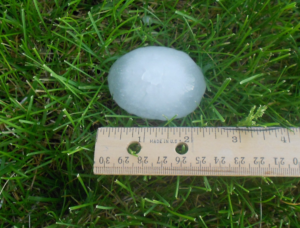We get asked a lot of questions as roofing professionals. While some of the questions involve how to choose a roofing contractor or what they can expect from the roofing process, many of them are concerning storms and the damage they do to their homes. Of all the storms the Midwest experiences, hail storms are the worst when it comes to damage to your roof. Most hail storms occur in the months of May through September, though they can occur at any time during the year. That means that the storm season is upon us and it’s always a good idea for home owners to know how they can spot hail damage and what to do next.
Knowing if You Have Hail Damage
Spotting hail damage on your roof has a lot to do with what type of roof you have. Damage to composition or asphalt shingles looks much different than damage to wood shingles. If you have asphalt shingles, you may notice that your shingles are losing granules and that the underlying materials are exposed. You may also notice that areas of your roof look polished or shiny or that parts of your roof are soft to the touch or spongy. Wood shingles may have splits in them or you may see splinters.
To really get a good idea of whether your roof has hail damage or not, you need to get on it—something we don’t recommend as it can be dangerous. If there was a heavy hail storm in your area and you believe your roof may have been impacted, it’s always best to call a professional like those at HomeWise Roofing and Exteriors. Our team can inspect your roof and determine if it needs repairs or replaced and answer any questions you have about the damage.
Determining the Severity of Your Hail Damage
Know you have hail damage but not sure how bad it is? You can sometimes tell how severe your hail damage is by paying attention to the hailstorm that caused it. The following factors will determine how much damage your roof has sustained:
- The size and density of the hail. How large and dense the hailstones are that strike your house is one of the biggest factors when it comes to damage to your roof. A hail stone can range anywhere in size from a pea to a softball. Stones with jagged corners and stones that are large are more likely to do damage to your home.
- The strength of the wind. The direction and strength of the wind involved in the hailstorm will determine how hard it strikes your roof. Obviously, the stronger the wind, the more damage your home will have.
There are a few other factors that can help you determine how much damage your roof has likely sustained after a hailstorm. They include:
- If there are any barriers. If you have barriers around your home such as fences, trees, other homes, or landscaping features, your home will be safer during a hailstorm and experience less damage.
- What your roof is made of. The quality and type of your roofing materials will affect how much wind and hail your roof can absorb before it becomes damaged. A hailstorm can easily crack tiles, ding metal roofing, and tear shingles. It can also create tears in vinyl coating. The better condition your roof is in and the higher quality of materials used, the less damage hail is likely to cause.
Knowing what to look for during and after a hailstorm will give you a better idea of how much damage it has caused to your roof. However, the only way to know for sure is to have an inspection done by a qualified roofing contractor like the pros at HomeWise. Have more questions about your roof or exterior of your home? Give us a call. We’d enjoy talking with you more.




